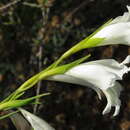Biology
(
Inglês
)
fornecido por Arkive
Like many species in the Cape Floristic Region, the blue pipe is a geophyte (4), meaning that it is capable of surviving long periods of unfavourable conditions by using an underground food storage organ (5). During the dry season, the above ground parts of the blue pipe die back, but the plant persists in the soil as a short, swollen stem known as a corm. In winter, the onset of the rains triggers the dormant corm to renew its above-ground growth (4) (5), with flowering occurring from June to August (2).
Conservation
(
Inglês
)
fornecido por Arkive
Like other plant communities within the Cape Floristic Region, such as fynbos, only a small proportion of renosterveld is protected (6). Through researching its ecology, the Cape Action for People and the Environment partnership is working to determine how best to manage renosterveld and conserve its biodiversity. These management strategies can then be employed by willing landowners, thereby ensuring that beautiful species such as the blue pipe are preserved (7).
Description
(
Inglês
)
fornecido por Arkive
A member of the iris family, the blue pipe is one of the many species of Gladiolus that grow in the incredibly biodiverse Cape Floristic Region (2) (4). The Latin name gracilis, meaning slender, accurately describes this species' appearance, with the leaves rolled into slim, hollow tubes which branch from a long, thin central stem. The blue pipe's most striking feature is its large, fragrant flowers. Reaching 2.5 centimetres in width, they are mainly blue or grey with dark streaks, although occasionally pink or yellow varieties occur (2).
Habitat
(
Inglês
)
fornecido por Arkive
The blue pipe generally occurs in renosterveld, a plant community unique to the Cape Floristic Region, which grows in regions with grey, clay-rich shale and granite soils, where annual rainfall is between 250 and 600 millimetres (2) (4).
Range
(
Inglês
)
fornecido por Arkive
The blue pipe is found only in the western and south-western regions of the Western Cape Province of South Africa (2).
Status
(
Inglês
)
fornecido por Arkive
Classified as Near Threatened (NT) on the Interim Red Data List of South African Plant Taxa (3).
Threats
(
Inglês
)
fornecido por Arkive
Since the arrival of the first European settlers, the highly-fertile soils which support renosterveld vegetation have been targeted for crop-growing (2). Today, the ongoing conversion to agriculture has consumed over 70 percent of renosterveld vegetation (4), leaving the remaining areas fragmented and subject to grazing, trampling, crop spraying and frequent burning (6). While there is no current information about the population status of the blue pipe, the ongoing degradation and loss of its principal habitat (4) are likely to be threatening its survival.
Gladiolus gracilis
(
Espanhol; Castelhano
)
fornecido por wikipedia ES
Gladiolus gracilis es una especie de gladiolo que se encuentra en Sudáfrica.
Descripción
Gladiolus gracilis es una planta herbácea perennifolia, geofita que alcanza un tamaño de 0.2 - 0.4 m de altura- Se encuentra a una altitud de 15 - 490 metros.[1]
Gladiolus gracilis es muy similar al Gladiolus caeruleus, pero es un poco más pequeño, tiene menos flores (de 2 a 5 en un pico), es generalmente de color azul a gris, pero de vez en cuando, rosa o amarillento y tiene rayas oscuras (en lugar de puntos) en los tépalos inferiores. El tépalo más inferior es generalmente más largo en esta especie en lugar de la mayoría de la misma longitud que los otros en G. caeruleus. Se encuentra principalmente en las laderas de arcilla (o granito) y florece en invierno.[2]
Taxonomía
Gladiolus gracilis fue descrita por Nikolaus Joseph von Jacquin y publicado en Collectanea 4: 159. 1792.[3]
- Etimología
Gladiolus: nombre genérico que se atribuye a Plinio y hace referencia, por un lado, a la forma de las hojas de estas plantas, similares a la espada romana denominada "gladius". Por otro lado, también se refiere al hecho de que en la época de los romanos la flor del gladiolo se entregaba a los gladiadores que triunfaban en la batalla; por eso, la flor es el símbolo de la victoria.[4][5]
gracilis: epíteto latíno que significa "delgada, esbelta".[6]
- Sinonimia
- Gladiolus gracilis var. gracilis
-
Gladiolus pterophyllus Pers.
-
Gladiolus recurvus Willd.
-
Gladiolus scaber Spreng. & Link
-
Gladiolus setifolius Eckl.
-
Gladiolus tristis var. punctatus Thunb.[7][8]
Referencias

- licença
- cc-by-sa-3.0
- direitos autorais
- Autores y editores de Wikipedia
Gladiolus gracilis: Brief Summary
(
Espanhol; Castelhano
)
fornecido por wikipedia ES
Gladiolus gracilis es una especie de gladiolo que se encuentra en Sudáfrica.
- licença
- cc-by-sa-3.0
- direitos autorais
- Autores y editores de Wikipedia
Gladiolus gracilis
(
Vietnamita
)
fornecido por wikipedia VI
Gladiolus gracilis là một loài thực vật có hoa trong họ Diên vĩ. Loài này được Jacq. miêu tả khoa học đầu tiên năm 1791.[1]
Chú thích
Liên kết ngoài
- licença
- cc-by-sa-3.0
- direitos autorais
- Wikipedia tác giả và biên tập viên
Gladiolus gracilis: Brief Summary
(
Vietnamita
)
fornecido por wikipedia VI
Gladiolus gracilis là một loài thực vật có hoa trong họ Diên vĩ. Loài này được Jacq. miêu tả khoa học đầu tiên năm 1791.
- licença
- cc-by-sa-3.0
- direitos autorais
- Wikipedia tác giả và biên tập viên

